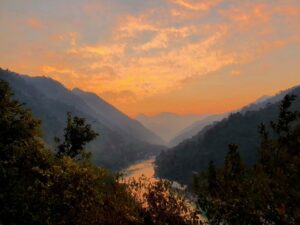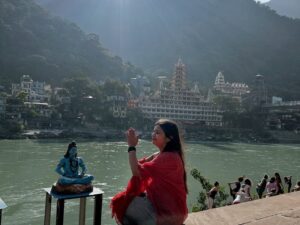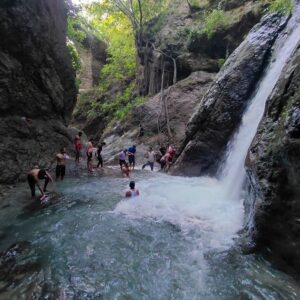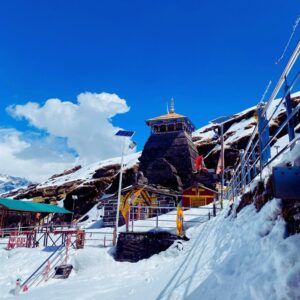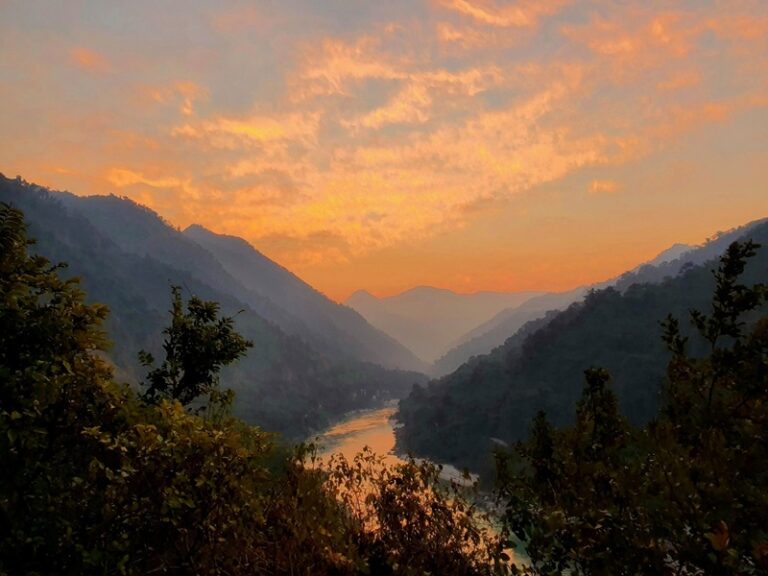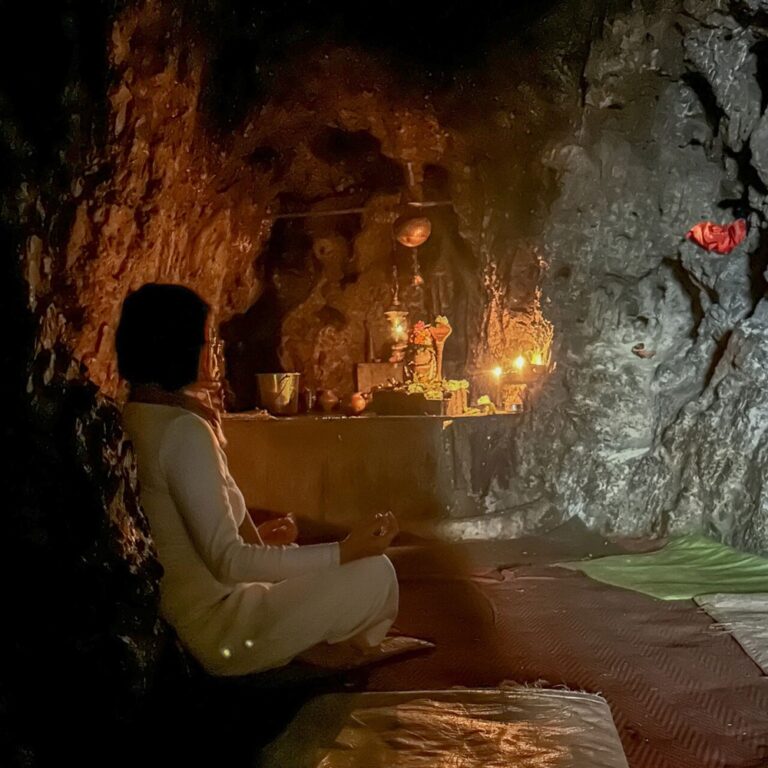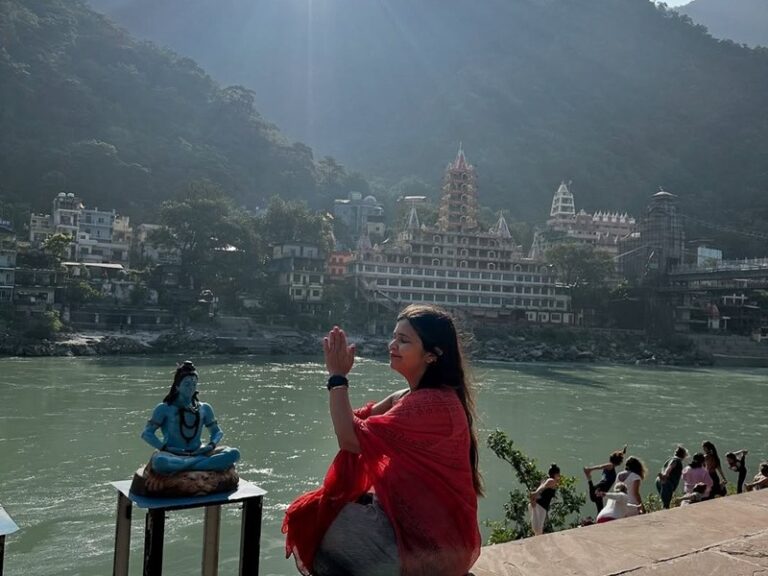Discover Rishikesh to Babaji Cave Distance, Road Trip Stops & Trek
For seekers and Kriya Yoga practitioners, the journey to the Himalayan foothills is incomplete without a pilgrimage to Mahavatar Babaji’s Cave. This sacred site, nestled high on the Pandukholi mountain near Dwarahat, is legendary as the place where the deathless guru Mahavatar Babaji initiated Lahiri Mahasaya into Kriya Yoga in 1861.
If you’re starting your spiritual journey from the spiritual hub of Rishikesh, you are likely asking: what is the true Rishikesh to Babaji Cave distance? The answer involves a significant drive followed by an essential mountain trek.
The Rishikesh to Babaji Cave Distance is 300 km by road via Devprayag, Rudraprayag, Karnapryag, Adi Badri, Gairsain, Chaukhutia, Dwarahat and Babaji Cave. The distance you are going to cover during your visit that truly transforms your whole existence.
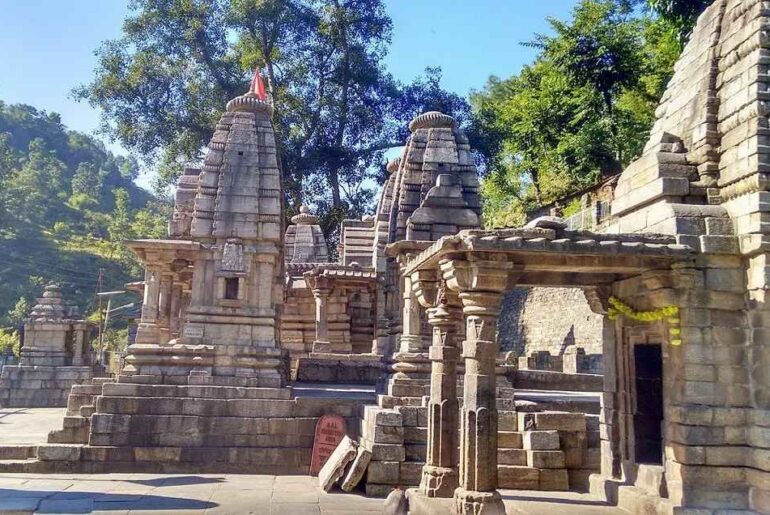
The True Rishikesh to Babaji Cave Distance
Mahavatar Babaji’s Cave is located in the Kumaon region of Uttarakhand, far from the Garhwal area where Rishikesh is situated. Therefore, the journey is not a simple day trip, but rather a multi-day spiritual expedition.
The total travel distance can be broken down into two main parts:
1. The Road Journey (Approx. 300 km)
The primary leg of the journey covers the mountainous road distance from Rishikesh to Kukuchina, the last motorable village near the cave site.
- Total Road Distance: Approximately 300 kilometers.
- Key Route: The scenic drive usually follows the path through holy confluence towns like Devprayag, Rudraprayag, and Karnaprayag, eventually leading towards the Kumaon region via places like Ranikhet or Almora, and finally to the town of Dwarahat.
- Travel Time: This lengthy drive typically takes 8 to 10 hours by private taxi, making an overnight stay in a town like Dwarahat or a nearby village essential for a comfortable journey.
I know you have covered many distances in your life so far, but, Rishikesh to Babaji Cave distance is filled with most scenic parts of the divine Himalayas and essence of the love of the god’s heart.

How to Travel from Rishikesh to Babaji Cave
Introduction
Babaji Cave stands as a powerful spiritual destination in the Himalayas. Every year, many travelers and seekers begin their journey from Rishikesh to reach this legendary meditation spot, known for its tranquil energy and scenic beauty. If you plan to visit, this guide shows you every step of the journey in clear, easy language.
Step-by-Step Journey
Start from Rishikesh
Begin your adventure in Rishikesh, the yoga capital of India. You can book a car, join a guided tour, or use public transport to start your journey.
Scenic Drive through Uttarakhand
- Drive from Rishikesh along the Ganges River.
- Take the road via Devprayag, Rudraprayag, and Karnaprayag. Enjoy the views and stop at Devprayag—the holy confluence of two rivers.
- Continue towards Adi Badri Temple, Dwarahat and Dunagiri Ma Temple, both peaceful spiritual spots.

Reach Dwarahat
You arrive at Dwarahat, a quiet town surrounded by hills. It’s wise to spend a night here to rest and adjust to the altitude. You find basic guesthouses and food options in town.
Drive to Kukuchina Village
From Dwarahat, drive 25km to Kukuchina Village. The road meanders through pine forests and stunning landscapes. Kukuchina marks the last motorable point.
Trek to Babaji Cave
Start your 2km uphill trek from Kukuchina to reach Babaji Cave. The path is clear and suitable for most age groups. The trek takes 45 minutes to 1 hour; go at your own pace and carry water/snacks.
Top Tip: The trek can feel steep in places. Walk slowly, enjoy the scenery, and take rest breaks. If you have health issues, check with a doctor before attempting the hike

Babaji Cave Rishikesh Key Stops:
Key Stops on the Route
| Location | Highlight |
| Vasishta Cave | Cave Meditation on the Bank of the Ganges |
| Devprayag | Holy river confluence Alakanada and Bhagirathi |
| Adi Badri Temple | Group of Temple for spiritual milestones |
| Dunagiri Temple | Peaceful hilltop shrine famous for Goddess Temple |
| Dwarahat | Overnight stop for rest, famous as city of temples |
| Kukuchina | Last village before trek, serene scenery and trek to Pandukholi |
| Babaji Cave | Sacred meditation cave, panoramic mountains |
While covering the Rishikesh to Babaji Cave Distance, on the way there are many truly divine places happen to see , first of all you will see the Vashishta Gufa that falls on short distance from Rishikesh, then after, our most favorite spot is Devprayag Sangam, here I can spend whole the day ( the meeting point of 2 divine holiest river of India , Bhagirathi and Alaknanda rivers, this is the very place which gives the birth of the name of the ” Ganga”.
After visiting Devprayag Sangam, You pass the Rudraprayag which is approx. 140 km from Rishikesh ( confluence of 2 holy rivers , Alaknanada And Mandakini ).
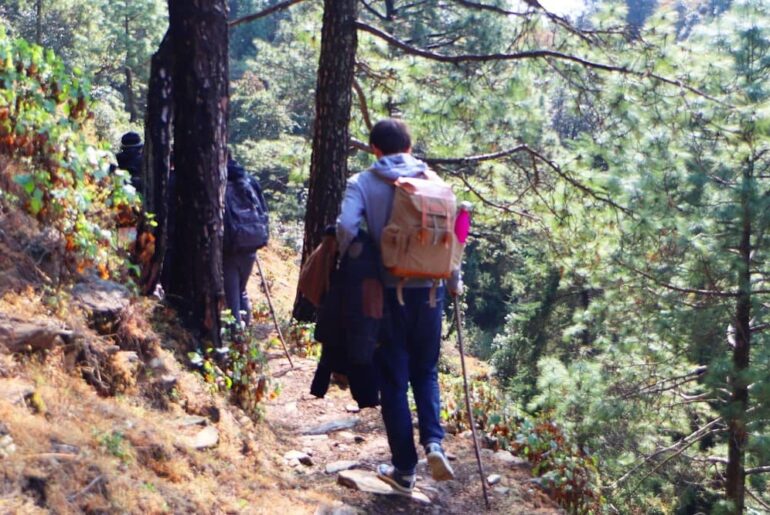
The Final Trek (Approx. 2 – 3 km)
The last stretch is where the motorable road ends, and the true pilgrimage begins. The final destination of the cave is located high above Kukuchina village.
- Starting Point: Kukuchina Village (the last motorable point).
- Trek Distance: The uphill trek from Kukuchina to Babaji’s Cave is roughly 2 to 3 kilometers.
- Trek Difficulty: The trail is considered moderate. While well-defined, it can be steep in certain sections, climbing through beautiful pine and rhododendron forests.
- Trek Time: For a person with average fitness, the ascent takes between 45 minutes to 1.5 hours each way.
Overview: Itinerary
Since the Rishikesh to Babaji Cave distance is substantial, planning a 2-Night, 3-Day itinerary is highly recommended:
- Day 1: Drive from Rishikesh to Dwarahat or a nearby home-stay near Kukuchina (approx. 8 hours). Use this day to acclimatize and rest.
- Day 2: Early morning drive to Kukuchina, followed by the uphill trek to Babaji’s Cave. Spend time meditating in the profoundly silent, powerful atmosphere. Return to your accommodation in the afternoon.
- Day 3: Drive back from Dwarahat to Rishikesh, visiting other spiritual spots like Vashishta Gufa along the way, if time allows.
This itinerary ensures you approach the sacred cave with minimal fatigue, allowing you to fully absorb the spiritual energy of this historic location.
For those traveling without a private vehicle, local buses run from Rishikesh to major towns like Dwarahat, but a dedicated taxi from Rishikesh offers the most reliable and direct route for covering the significant Rishikesh to Babaji Cave distance.

Highlights of the Babaji Cave
- Enter the sacred cave where Mahavatar Babaji is believed to have taught Kriya Yoga to Lahiri Mahasaya, as described in the classic, “Autobiography of a Yogi”.
- The area bursts with pine-scented air and panoramic Himalayan views.
- You can meditate in the cave’s peaceful setting; silence is observed inside, and everyone removes shoes before entering.
Best Time to Visit Babaji Cave
- April to June and September to November provide the most pleasant weather.
- You can visit year-round, but avoid the monsoon months due to slippery trails.
Tips for All Ages
- The trek is moderate but manageable for children and older adults with basic fitness.
- Carry warm clothing, especially in winter. Take extra care if you have breathing difficulties because of the altitude.
- Facilities at the cave are minimal. Pack essentials like water, snacks, and a basic first aid kit.
- Local guides and drivers are helpful, especially if you’re less experienced with Himalayan treks

Karanprayag
Karanprayag is another holy town in the Himalayas which falls on the way to Babaji cave from Rishikesh, the distance is about 200 km from Rishikesh. Here, you see the confluence of 2 another holy rivers, Alaknanda and Pindar River, along with ancient temple Shiva and Uma.
After Karnprayag you pass through the most revered temple out of Panch Badri Temples in Uttarakhand’ Himalayas, which is known as Adi Badri Group of temples, approx. 16 temples in the temple’s complex.
While beating the Rishikesh to Babaji Cave Distance, you encounter most enchanting town of the Himalayas which is known as Uttar Dwarka, a town of temples, there are more then 100 temples scattered in this tiny town.
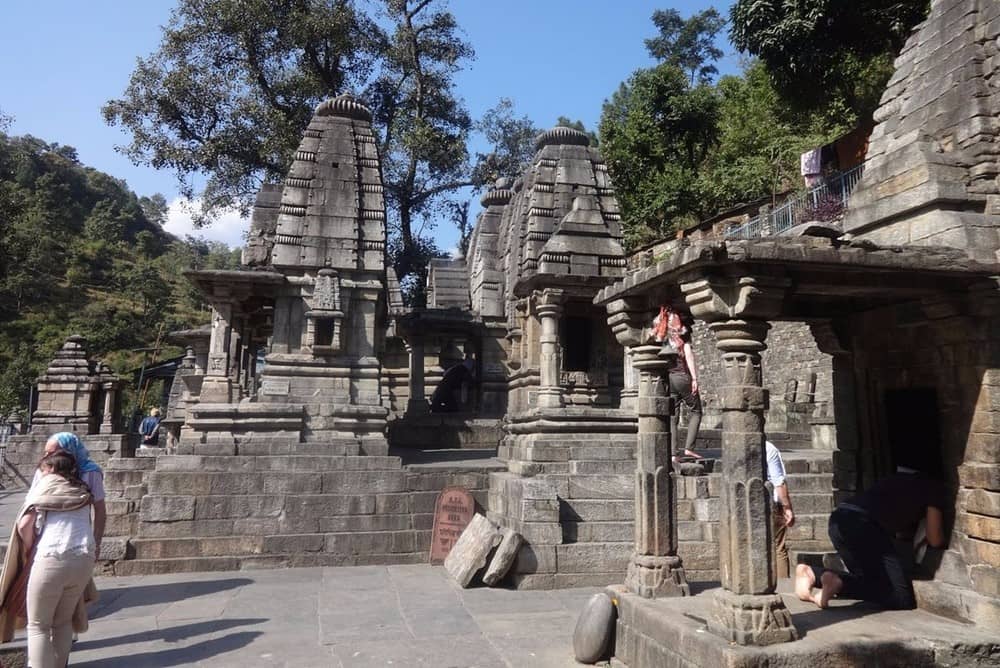
Detailed Itinerary
Day 1: Rishikesh to Dwarahat 275 km ( Rishikesh to Babaji Cave Distance is 300 km )
The Rishikesh to Babaji Cave Distance is 300 km by road, the tour begins with an early breakfast, setting the stage for a direct drive to Babaji Cave, with captivating stops along the way. Our journey will lead us to Dwarahat, where we’ll spend the night.
- Vashistha Cave: Our first stop en route to Babaji Cave is the ancient Vashistha Cave, celebrated for its stunning views and conducive atmosphere for meditation.
- DevPrayag: Our second stop is Dev Prayag, the sacred confluence of the Bhagirathi and Mandakini rivers, which marks the literal origin of the revered Ganges River. Here, we’ll have the opportunity to physically witness this divine convergence.
- Rudraprayag: Next, we’ll see from distance Rudraprayag, where the mighty Alaknanda and Mandakini rivers merge, offering a distant yet mesmerizing view of this natural spectacle.
- Karnaprayag: Our journey continues to Karnaprayag, where the Alaknanda and Pindar rivers converge, providing another picturesque distant view of nature’s harmony.

Day 2 Dwarahat to Babaii Cave 25 km
- is dedicated to exploring the legendary Mahavatar Babaji Cave, where the sage imparted his profound teachings on Kriya Yoga to Lahiri Mahasaya. After breakfast, we’ll embark on a trek to the cave, commencing around 9 AM and lasting approximately 60-90 minutes.
- Upon arrival at the cave around 11:30 AM, we’ll engage in meditation, allowing ample time to absorb the cave’s energy and explore nearby sites like the YSS Hut. Later, as we trek back, we’ll visit Dunagiri Temple & YSS Ashram in Dwarahat before returning to our hotel for dinner and rest.
Day 3 Dwarahat to Rishikesh
- We’ll journey from Dwarahat back to Rishikesh, covering approximately 280 kilometers over 9 to 10 hours. After breakfast, we’ll proceed towards Rishikesh, with a notable stop en route at Sri Adi Badri, a cluster of temples dating back to the 9th and 10th centuries, which stand as the oldest temples in the Himalayan region.

Conclusion
Traveling from Rishikesh to Babaji Cave connects you with Himalayan beauty and deep spirituality. You will find adventure, peace, and a sense of wonder along the way. Prepare well, travel safely, and let the journey inspire you at every step
FAQ
Here are some frequently asked questions about visiting Mahavatar Babaji Cave:
- Where is the cave located? The cave is located in Kukuchina, near Dwarahat in the Almora district of Uttarakhand, on the Pandukholi Mountain.
- How do I get there? You can reach Kukuchina by taxi or car from Dwarahat . From Kukuchina, it’s a trek of about 2-3 km to the cave . The Yogoda Satsanga Sakha Ashram in Dwarahat can provide guidance on reaching the cave .
- How long does the trek take? The trek from Kukuchina to the cave takes about 45-60 minutes for a healthy person. The round trip from the Ashram can take about six to eight hours.
- Is the trek difficult? The trek is an established path of dirt and rock that can be steep in places, with uneven steps. It’s described as a hike or climb rather than a casual stroll, and may not be suitable for those who have difficulty climbing stairs or walking on uneven ground.
- What are the visiting hours? The cave is generally open from 9:00 am to 3:30 pm, with slightly different timings for summers and winters.
- Is there an entry fee? No, entry to the cave is free .
- Can I meditate in the cave? Yes, devotees and Kriya Yogis visit the cave for meditation.
- Where can I stay? You can stay at the Yogoda Satsanga Sakha Ashram in Dwarahat if you are a member . There are also guesthouses in Kukuchina, such as Joshi Guest House, and hotels in Dwarahat. Some people also stay at the Pandavkholi Dharamshala, a basic shelter on the hill above the cave.
- What is the best time to visit? The best time to visit is from September to May, when the weather is favorable .
- What should I bring? It is advised to wear comfortable footwear and carry water and snacks .
- is Mahavatar Babaji still alive?: According to the beliefs of his followers and accounts in texts like “Autobiography of a Yogi,” Mahavatar Babaji is considered to be an immortal yogi who is still alive . He is believed to have the ability to change his physical appearance and is said to reside in the Himalayan regions.
- Where is Mahavatar Babaji now?: Based on the beliefs of his followers, Mahavatar Babaji is considered to be an immortal yogi who continues to live in the remote Himalayan region.
- is Mahavatar Babaji real?: Yes, according to the beliefs of his followers, Mahavatar Babaji is considered to be a real and immortal being.
- who is Babaji?: Mahavatar Babaji is a figure revered as a great Himalayan yogi and guru by his followers . He is believed to be an immortal being who has lived for centuries.
- Babaji cave location?: Mahavatar Babaji Cave is located in Kukuchina, a hamlet near Dwarahat in the Almora district of Uttarakhand. It is situated on the Pandukholi Mountain 2. The cave is about 25 km from Dwarahat and approximately 3 km from Kukuchina.
It’s recommended to read Chapter 34 of “Autobiography of a Yogi” to understand the historical significance of the cave before visiting.
Rishikesh to Babaji Cave Rishikesh to Babaji Cave Rishikesh to Babaji Cave Rishikesh to Babaji Cave Rishikesh to Babaji Cave Rishikesh to Babaji Cave Rishikesh to Babaji Cave Rishikesh to Babaji Cave Rishikesh to Babaji Cave
Rishikesh to Babaji Cave distance Rishikesh to Babaji Cave distance Rishikesh to Babaji Cave distance


